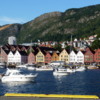Bryggen (it actually means waterfront) is the historic wharf area of Bergen, Norway, widely known for its brightly-colored warehouses and its long history. Most of the oldest buildings date to the heyday of the Hanseatic presence here from the 14th to 17th centuries, but the origins date to the 12th century. It's a UNESCO World Heritage site.
The Hanseatic League was a confederation of mostly German Baltic Sea trading towns, cities and companies that dominated trade in northern Europe for centuries, and functioned as a government in many areas.
Here in Bergen, they established a Kontor, or buying office, that bought fish and sold goods from their home cities. The fish were salted for preservation and sorted into many different grades...some of the first standardized food commodities anywhere. There's a fascinating museum of the Hansa era that occupies several of the old buildings.
Today, Bergen, though small, is still Norway's second-largest city. Fish is still important, but so is Bergen's role as a cruise port, and as the western anchor of the inland ships that ply the Sognefjord and other western fjords. Locals rely on that through the roadless winters, and tourists travel that route in the famous Norway in a Nutshell route.
For more about Bergen, see TravelGumbo's recent Bergen blog.



Comments (0)